load capacity SUBARU BAJA 2005 1.G Owners Manual
[x] Cancel search | Manufacturer: SUBARU, Model Year: 2005, Model line: BAJA, Model: SUBARU BAJA 2005 1.GPages: 469, PDF Size: 5.24 MB
Page 278 of 469

8-1
8
Driving tips
New vehicle break-in driving – the first 1,000 miles (1,600 km) ............................... 8-2
Fuel economy hints ...................................... 8-2
Engine exhaust gas (Carbon monoxide) .... 8-3
Catalytic converter ........................................ 8-4
Periodic inspections ..................................... 8-6
Driving in foreign countries ......................... 8-6
Driving tips for AWD vehicles ...................... 8-7
Off road driving ............................................. 8-9
Winter driving ................................................ 8-11 Operation during cold weather ........................ 8-11
Driving on snowy and icy roads ...................... 8-13
Corrosion protection ........................................ 8-14
Snow tires .......................................................... 8-14
Tire chains ......................................................... 8-15
Rocking the vehicle .......................................... 8-16
Loading your vehicle .................................... 8-16 Vehicle capacity weight ................................... 8-18
GVWR and GAWR (Gross Vehicle Weight Rating and Gross Axle Weight Rating) ........ 8-19
Trailer hitch (if equipped) ............................. 8-20 Connecting a trailer .......................................... 8-20
When you do not tow a trailer ......................... 8-24
Trailer towing ................................................ 8-24 Warranties and maintenance ........................... 8-24
Maximum load limits ........................................ 8-25
Trailer hitches ................................................... 8-30
Connecting a trailer .......................................... 8-30
Trailer towing tips ............................................. 8-33
Page 295 of 469
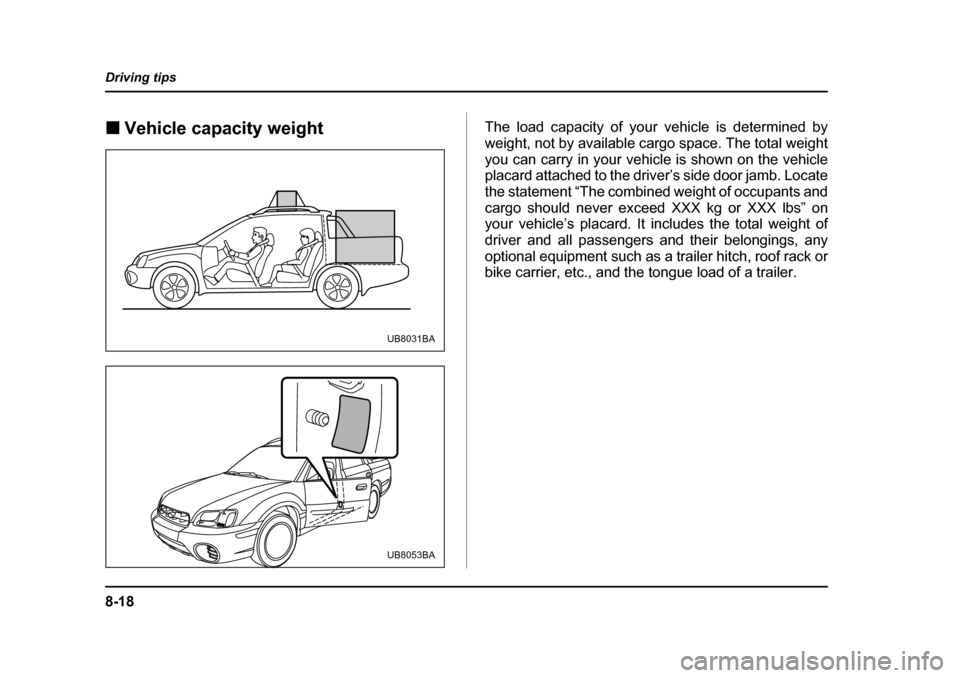
8-18
Driving tips
�„
Vehicle capacity weight The load capacity of your vehicle is determined by
weight, not by available cargo space. The total weight
you can carry in your vehicle is shown on the vehicle
placard attached to the driver’s side door jamb. Locate
the statement “The combined weight of occupants and
cargo should never exceed XXX kg or XXX lbs” on
your vehicle’s placard. It includes the total weight of
driver and all passengers and their belongings, any
optional equipment such as a trailer hitch, roof rack or
bike carrier, etc., and the tongue load of a trailer.
UB8031BA
UB8053BA
Page 296 of 469
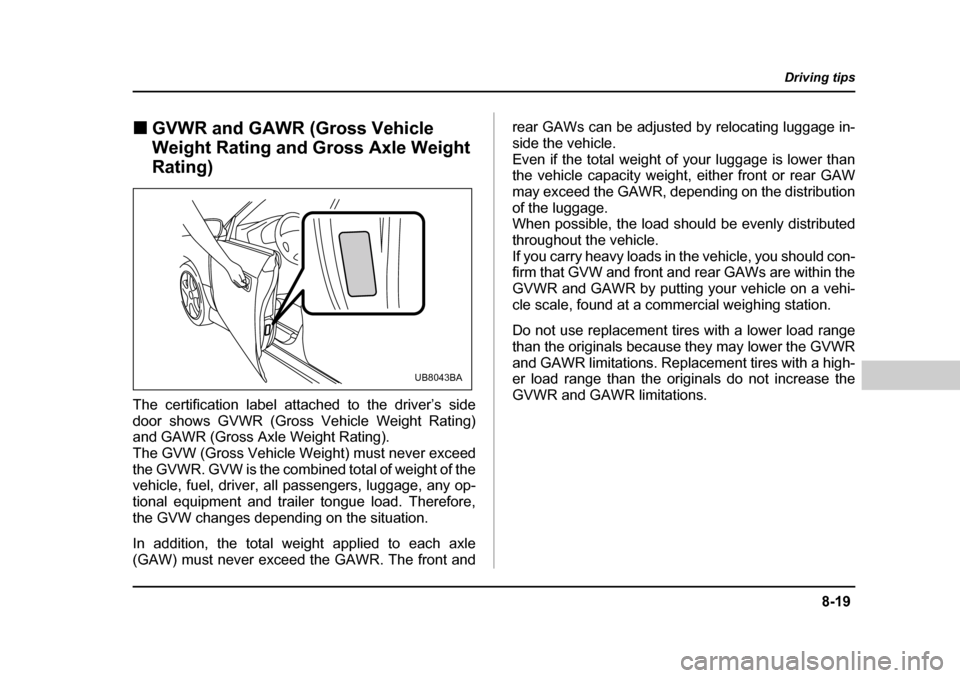
8-19
Driving tips
– CONTINUED –
�„GVWR and GAWR (Gross Vehicle
Weight Rating and Gross Axle Weight
Rating)
The certification label attached to the driver’s side
door shows GVWR (Gross Vehicle Weight Rating)
and GAWR (Gross Axle Weight Rating).
The GVW (Gross Vehicle Weight) must never exceed
the GVWR. GVW is the combined total of weight of the
vehicle, fuel, driver, all passengers, luggage, any op-
tional equipment and trailer tongue load. Therefore,
the GVW changes depending on the situation.
In addition, the total weight applied to each axle
(GAW) must never exceed the GAWR. The front and rear GAWs can be adjusted by relocating luggage in-
side the vehicle.
Even if the total weight of your luggage is lower than
the vehicle capacity weight, either front or rear GAW
may exceed the GAWR, depending on the distribution
of the luggage.
When possible, the load should be evenly distributed
throughout the vehicle.
If you carry heavy loads in the vehicle, you should con-
firm that GVW and front and rear GAWs are within the
GVWR and GAWR by putting your vehicle on a vehi-
cle scale, found at a commercial weighing station.
Do not use replacement tires with a lower load range
than the originals because they may lower the GVWR
and GAWR limitations. Replacement tires with a high-
er load range than the originals do not increase the
GVWR and GAWR limitations.
UB8043BA
Page 309 of 469
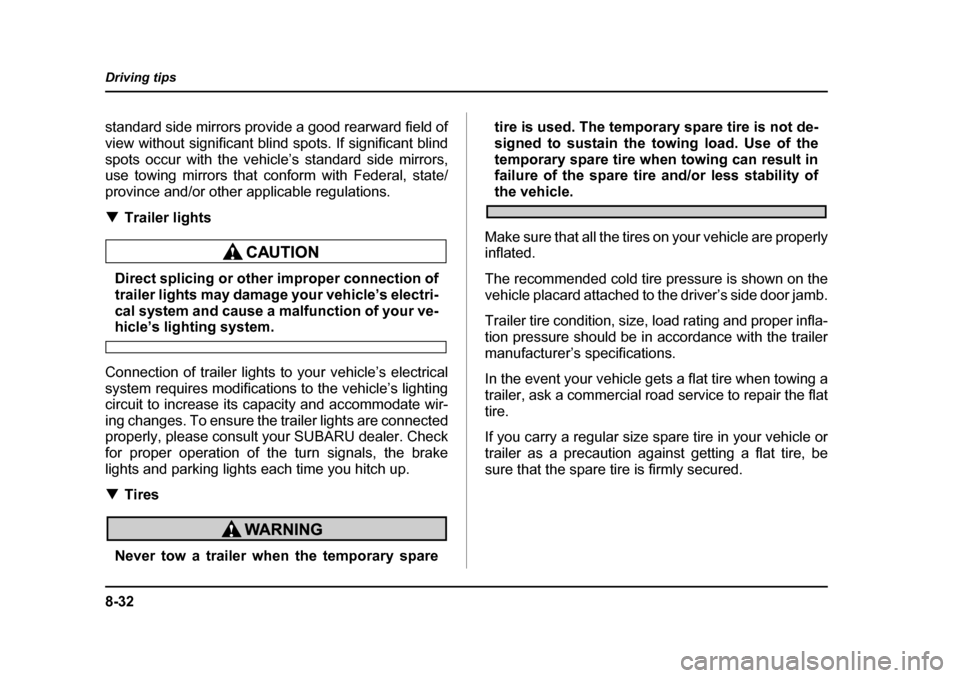
8-32
Driving tips
standard side mirrors provide a good rearward field of
view without significant blind spots. If significant blind
spots occur with the vehicle’s standard side mirrors,
use towing mirrors that conform with Federal, state/
province and/or other applicable regulations. �T
Trailer lights
Direct splicing or other improper connection of
trailer lights may damage your vehicle’s electri-
cal system and cause a malfunction of your ve-
hicle’s lighting system.
Connection of trailer lights to your vehicle’s electrical
system requires modifications to the vehicle’s lighting
circuit to increase its capacity and accommodate wir-
ing changes. To ensure the trailer lights are connected
properly, please consult your SUBARU dealer. Check
for proper operation of the turn signals, the brake
lights and parking lights each time you hitch up. �T Tires
Never tow a trailer when the temporary spare tire is used. The temporary spare tire is not de-
signed to sustain the towing load. Use of the
temporary spare tire when towing can result in
failure of the spare tire and/or less stability of
the vehicle.
Make sure that all the tires on your vehicle are properly
inflated.
The recommended cold tire pressure is shown on the
vehicle placard attached to the driver’s side door jamb.
Trailer tire condition, size, load rating and proper infla-
tion pressure should be in accordance with the trailer
manufacturer’s specifications.
In the event your vehicle gets a flat tire when towing a
trailer, ask a commercial road service to repair the flat tire.
If you carry a regular size spare tire in your vehicle or
trailer as a precaution against getting a flat tire, be
sure that the spare tire is firmly secured.
Page 447 of 469
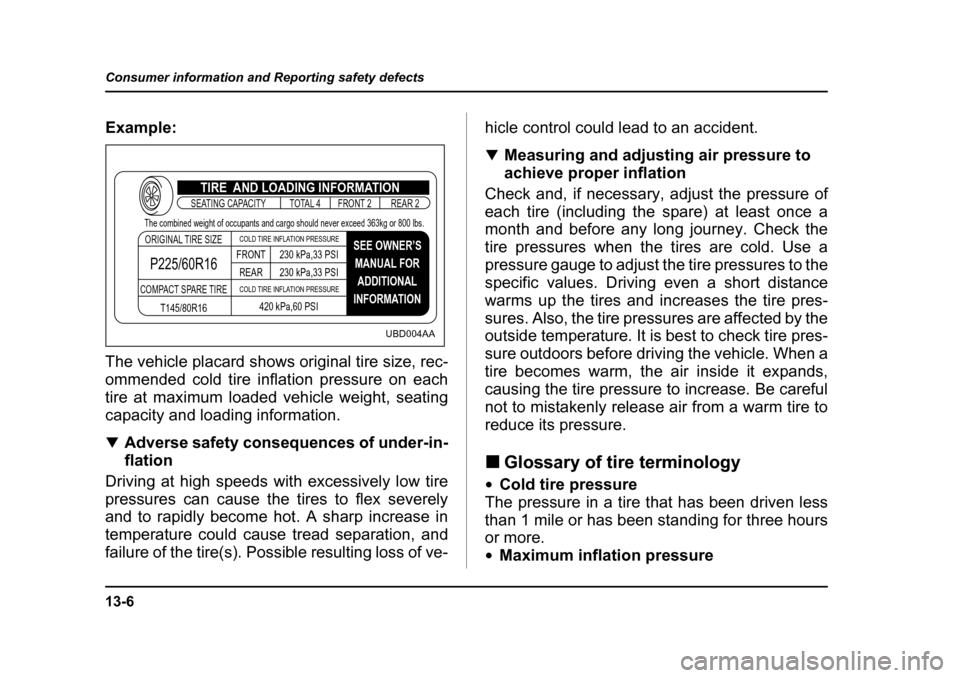
13-6
Consumer information and Reporting safety defects
Example:
The vehicle placard shows original tire size, rec-
ommended cold tire inflation pressure on each
tire at maximum loaded vehicle weight, seating
capacity and loading information. �T
Adverse safety consequences of under-in-
flation
Driving at high speeds with excessively low tire
pressures can cause the tires to flex severely
and to rapidly become hot. A sharp increase in
temperature could cause tread separation, and
failure of the tire(s). Possible resulting loss of ve- hicle control could lead to an accident. �T
Measuring and adjusting air pressure to
achieve proper inflation
Check and, if necessary, adjust the pressure of
each tire (including the spare) at least once a
month and before any long journey. Check the
tire pressures when the tires are cold. Use a
pressure gauge to adjust the tire pressures to the
specific values. Driving even a short distance
warms up the tires and increases the tire pres-
sures. Also, the tire pressures are affected by the
outside temperature. It is best to check tire pres-
sure outdoors before driving the vehicle. When a
tire becomes warm, the air inside it expands,
causing the tire pressure to increase. Be careful
not to mistakenly release air from a warm tire to
reduce its pressure. �„ Glossary of tire terminology
�y Cold tire pressure
The pressure in a tire that has been driven less
than 1 mile or has been standing for three hours
or more. �y Maximum inflation pressure
TIRE AND LOADING INFORMATION
SEE OWNER’S
MANUAL FOR ADDITIONAL
INFORMATION
SEATING CAPACITY
ORIGINAL TIRE SIZE
COLD TIRE INFLATION PRESSURE
COLD TIRE INFLATION PRESSURE
FRONT REAR 230 kPa,33 PSI 230 kPa,33 PSI
420 kPa,60 PSI
COMPACT SPARE TIRE
T145/80R16
P225/60R16
The combined weight of occupants and cargo should never exceed 363kg or 800 lbs.
TOTAL 4 FRONT 2 REAR 2
UBD004AA
Page 448 of 469

13-7
Consumer information and Reporting safety defects
– CONTINUED –
The maximum cold inflation pressure to which a
tire may be inflated. �yRecommended inflation pressure
The cold inflation pressure recommended by a
vehicle manufacturer. �y Intended outboard sidewall
1)The sidewall that contains a whitewall, bears
white lettering or bears manufacturer, brand,
and/or model name molding that is higher or
deeper than the same molding on the other
sidewall of the tire, or
2)The outward facing sidewall of an asymmet-
rical tire that has a particular side that must al-
ways face outward when mounting on a vehi-
cle.
�y Accessory weight
The combined weight (in excess of those stan-
dard items which may be replaced) of floor mats,
leather seats, cross bars and cargo bed extender
to the extent that these items are available as
factory-installed equipment (whether installed or
not). �y Curb weight
The weight of a motor vehicle with standard
equipment including the maximum capacity of fu- el, oil, and coolant and air conditioning.�y
Maximum loaded vehicle weight
The sum of curb weight, accessory weight, vehi-
cle capacity weight and production options weight. �y Normal occupant weight
150 lbs (68 kg) times the number of occupants (2
occupants). �y Occupant distribution
Distribution of occupants in a vehicle, 2 in front. �y Production options weight
The combined weight of those installed regular
production options weighing over 5.1 lbs (2.3 kg)
in excess of those standards items which they
replace, not previously considered in curb weight
or accessory weight. �y Vehicle capacity weight
The total weight of cargo, luggage and occu-
pants that can be added to the vehicle. �y Vehicle maximum load on a tire
Load on an individual tire that is determined by
distributing to each axle its share of the maxi-
mum loaded vehicle weight and dividing by two. �y Vehicle normal load on a tire
Load on an individual tire that is determined by
Page 449 of 469

13-8
Consumer information and Reporting safety defects
distributing to each axle its share of the curb
weight, accessory weight, and normal occupant
weight and dividing by two. �„
Tire care – maintenance and safety
practices
�y Check on a daily basis that the tires are free
from serious damage, nails, and stones. At the
same time, check the tires for abnormal wear. �y Inspect the tire tread regularly and replace the
tires before their tread wear indicators become
visible. When a tire’s tread wear indicator be-
comes visible, the tire is worn beyond the ac-
ceptable limit and must be replaced immediately.
With a tire in this condition, driving at even low
speeds in wet weather can cause the vehicle to
hydroplane. Possible resulting loss of vehicle
control can lead to an accident. �y To maximize the life of each tire and ensure
that the tires wear uniformly, it is best to rotate
the tires every 7,500 miles (12,500 km). Rotating
the tires involves switching the front and rear
tires on the right hand side of the vehicle and
similarly switching the front and rear tires on the left hand side of the vehicle. (Each tire must be
kept on its original side of the vehicle.) Replace
any damaged or unevenly worn tire at the time of
rotation. After tire rotation, adjust the tire pres-
sures and make sure the wheel nuts are correct-
ly tightened. A tightening torque specification
and a tightening sequence specification for the
wheel nuts can be found “Flat tires” in Chapter 9. �„
Vehicle load limit – how to determine
The load capacity of your vehicle is determined
by weight, not by available cargo space. The
load limit of your vehicle is shown on the vehicle
placard attached to the driver’s side B-pillar. Lo-
cate the statement “The combined weight of oc-
cupants and cargo should never exceed XXX kg
or XXX lbs” on your vehicle’s placard.
The vehicle placard also shows seating capacity
of your vehicle.
The total load capacity includes the total weight
of driver and all passengers and their belong-
ings, any cargo, any optional equipment such as
a trailer hitch, roof rack or bike carrier, etc., and
the tongue load of a trailer. Therefore cargo ca-
Page 450 of 469
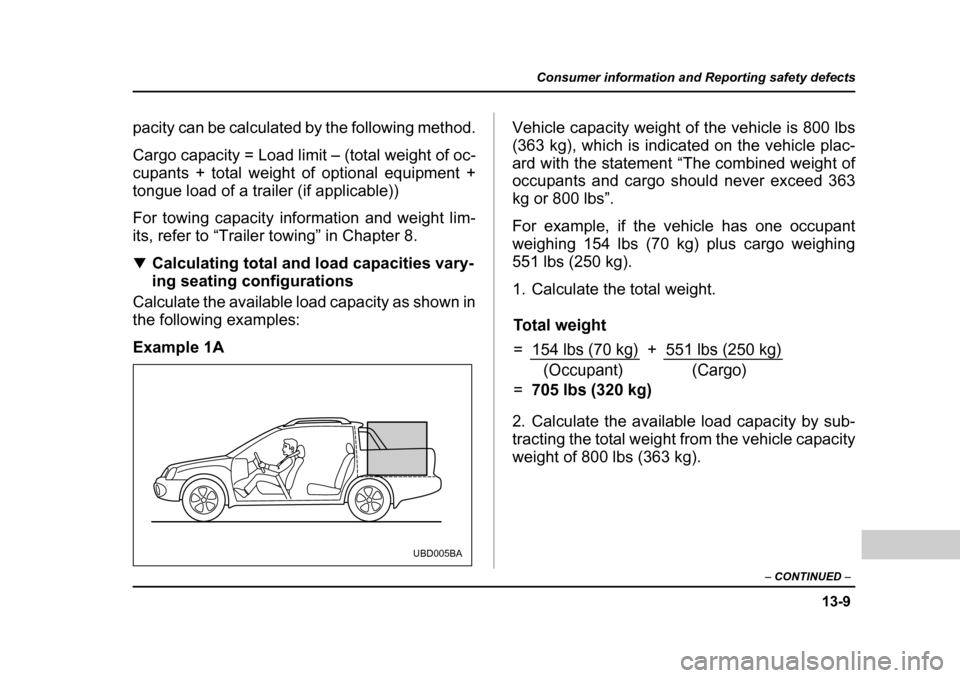
13-9
Consumer information and Reporting safety defects
– CONTINUED –
pacity can be calculated by the following method.
Cargo capacity = Load limit – (total weight of oc-
cupants + total weight of optional equipment +
tongue load of a trailer (if applicable))
For towing capacity information and weight lim-
its, refer to “Trailer towing” in Chapter 8. �TCalculating total and load capacities vary-
ing seating configurations
Calculate the available load capacity as shown in
the following examples:
Example 1A Vehicle capacity weight of the vehicle is 800 lbs
(363 kg), which is indicated on the vehicle plac-
ard with the statement “The combined weight of
occupants and cargo should never exceed 363
kg or 800 lbs”.
For example, if the vehicle has one occupant
weighing 154 lbs (70 kg) plus cargo weighing
551 lbs (250 kg).
1. Calculate the total weight.
2. Calculate the available load capacity by sub-
tracting the total weight from the vehicle capacity
weight of 800 lbs (363 kg).
UBD005BA
Total weight = 154 lbs (70 kg) + 551 lbs (250 kg) =
705 lbs (320 kg)(Occupant) (Cargo)
Page 451 of 469
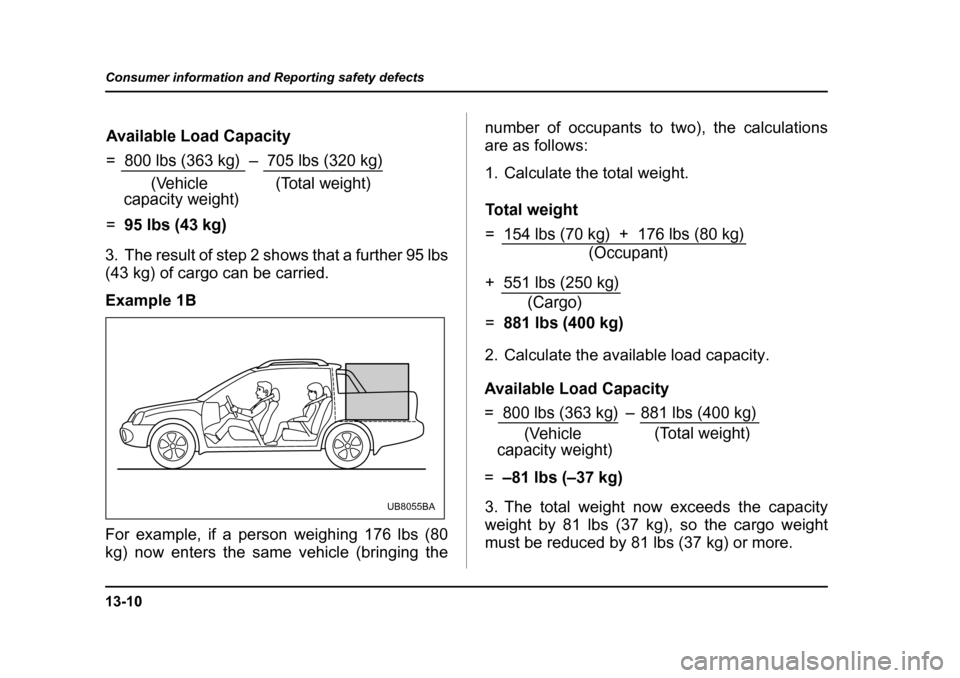
13-10
Consumer information and Reporting safety defects
3. The result of step 2 shows that a further 95 lbs
(43 kg) of cargo can be carried.
Example 1B
For example, if a person weighing 176 lbs (80
kg) now enters the same vehicle (bringing the
number of occupants to two), the calculations
are as follows:
1. Calculate the total weight.
2. Calculate the available load capacity.
3. The total weight now exceeds the capacity
weight by 81 lbs (37 kg), so the cargo weight
must be reduced by 81 lbs (37 kg) or more.
Available Load Capacity = 800 lbs (363 kg) – 705 lbs (320 kg) =
95 lbs (43 kg) (Vehicle
capacity weight) (Total weight)
UB8055BA
Total weight = 154 lbs (70 kg) + 176 lbs (80 kg) + 551 lbs (250 kg) =
881 lbs (400 kg) (Occupant)
(Cargo)
Available Load Capacity
= 800 lbs (363 kg) 881 lbs (400 kg) = 81 lbs ( 37 kg)(Vehicle
capacity weight) (Total weight)
Page 452 of 469
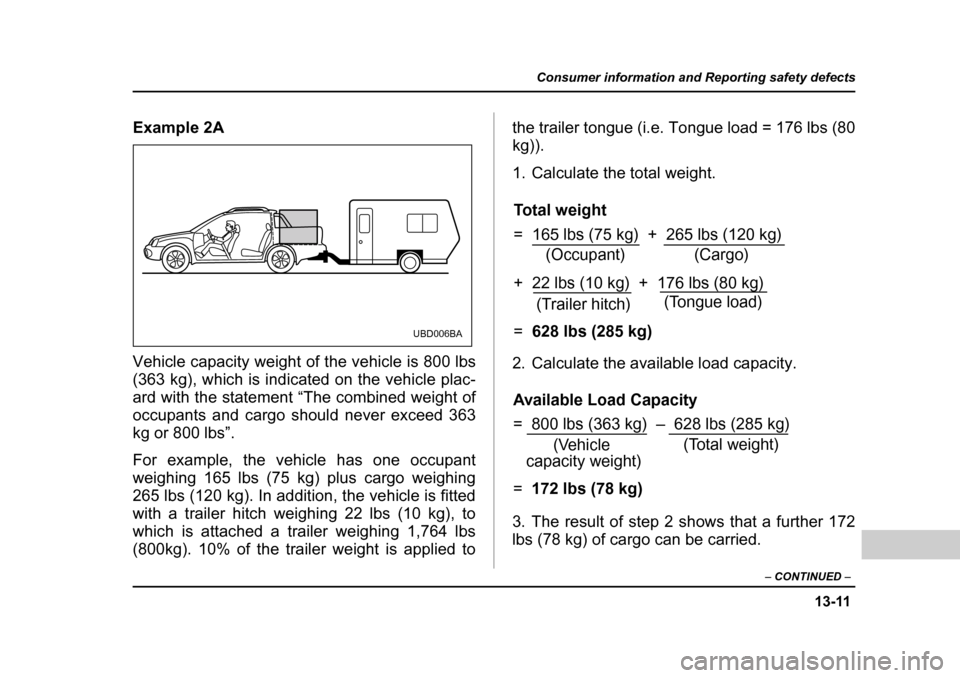
13-11
Consumer information and Reporting safety defects
– CONTINUED –
Example 2A
Vehicle capacity weight of the vehicle is 800 lbs
(363 kg), which is indicated on the vehicle plac-
ard with the statement “The combined weight of
occupants and cargo should never exceed 363
kg or 800 lbs”.
For example, the vehicle has one occupant
weighing 165 lbs (75 kg) plus cargo weighing
265 lbs (120 kg). In addition, the vehicle is fitted
with a trailer hitch weighing 22 lbs (10 kg), to
which is attached a trailer weighing 1,764 lbs
(800kg). 10% of the trailer weight is applied to the trailer tongue (i.e. Tongue load = 176 lbs (80kg)).
1. Calculate the total weight.
2. Calculate the available load capacity.
3. The result of step 2 shows that a further 172
lbs (78 kg) of cargo can be carried.
UBD006BA
Total weight
= 165 lbs (75 kg) + 265 lbs (120 kg)
+ 22 lbs (10 kg) + 176 lbs (80 kg) =
628 lbs (285 kg)(Occupant) (Cargo)
(Trailer hitch) (Tongue load)
Available Load Capacity
= 800 lbs (363 kg) – 628 lbs (285 kg) =
172 lbs (78 kg) (Vehicle
capacity weight) (Total weight)